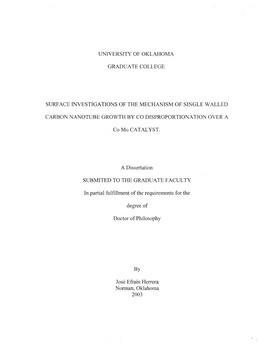| dc.contributor.advisor | Resasco, Daniel E., | en_US |
| dc.contributor.author | Herrera Perea, Jose Efrain. | en_US |
| dc.date.accessioned | 2013-08-16T12:19:02Z | |
| dc.date.available | 2013-08-16T12:19:02Z | |
| dc.date.issued | 2003 | en_US |
| dc.identifier.uri | https://hdl.handle.net/11244/632 | |
| dc.description.abstract | To examine the validity of this hypothesis different catalyst formulations and reaction conditions have been used. These series of tests included the doping of the Co Mo catalyst with sodium, the substitution of molybdenum by tungsten in the original catalyst formulation, the variation on reaction temperature as well as the introduction of hydrogen in the gas feedstock. All these modifications were carried out in order to modify the growth conditions in which the SWNT are formed. The results are consistent with the proposed hypothesis and have opened the possibility of tailoring the properties of the SWNT obtained. | en_US |
| dc.description.abstract | Single-wall carbon nanotubes (SWNT) are considered one of the building blocks for nanoscale science and nanotechnology. Extensive research work is now focused on the large-scale manufacture of these materials since there is not yet an established method that provides large quantities of SWNT of well-determined and reproducible characteristics. A clear understanding of the formation mechanism of SWNT is therefore a key issue for the development of further advances in this topic. | en_US |
| dc.description.abstract | This study is focused on the understanding of the processes that occur on the catalyst surface during the synthesis of SWNT nanotubes by CO disproportionation over a bimetallic Co Mo catalyst. A series of analytical techniques have been employed to fully characterize the structure and chemical state of the catalyst. The state of Co and Mo has been investigated using laser Raman spectroscopy, extended X-ray absorption fine structure spectroscopy, X-ray absorption near-edge spectroscopy, ultraviolet-visible diffuse reflectance spectroscopy, Hz temperature-programmed reduction, X-ray photoelectron spectroscopy, and diffuse reflectance Fourier transform infrared spectroscopy of adsorbed NO; after two sequential pretreatments and after the production of SWNT under pure CO. In a similar way, the SWNT materials have been characterized using laser Raman spectroscopy, transmission electron microscopy, optical absorption spectroscopy and fluorescence. The information obtained during the catalyst characterization revealed an intrinsic dependence between the selectivity of the catalysts toward SWNT and the stabilization of Co species in a nonmetallic state, which in turn results from an interaction with Mo in the form of a surface Co molybdate-like structure. | en_US |
| dc.format.extent | xxvii, 273 leaves : | en_US |
| dc.subject | Nanotubes. | en_US |
| dc.subject | Carbon. | en_US |
| dc.subject | Engineering, Chemical. | en_US |
| dc.subject | Catalysts. | en_US |
| dc.subject | Nanotechnology. | en_US |
| dc.subject | Chemistry, Inorganic. | en_US |
| dc.title | Surface investigations of the mechanism of single walled carbon nanotube growth by carbon monoxide disproportionation over a cobalt-molybdenum catalyst. | en_US |
| dc.type | Thesis | en_US |
| dc.thesis.degree | Ph.D. | en_US |
| dc.thesis.degreeDiscipline | School of Chemical, Biological and Materials Engineering | en_US |
| dc.note | Source: Dissertation Abstracts International, Volume: 64-07, Section: B, page: 3396. | en_US |
| dc.note | Adviser: Daniel E. Resasco. | en_US |
| ou.identifier | (UMI)AAI3097223 | en_US |
| ou.group | College of Engineering::School of Chemical, Biological and Materials Engineering | |
